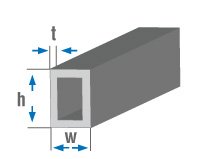Box Profile Weight Calculation
How to Calculate Profile Weight?
Calculating profile weight is crucial for selecting the right materials and optimizing your costs. Weight calculation tools provided by Yakup Yılmaz Boru enable you to calculate profile weight quickly and accurately.
1. Determine the Profile's Cross-Sectional Area:
To determine the cross-sectional area (A) of the profile, use the appropriate formula based on its shape. For example:
- Rectangular Profile: Cross-sectional area (A) = Width (b) x Height (h)
- Square Profile: Cross-sectional area (A) = Side length²
- Circular Profile: Cross-sectional area (A) = π x (radius²)
2. Determine the Length:
Measure the length (L) of the profile or find it in technical documents.
3. Determine Material Density:
Find out the density of the material used. For example:
- Steel: 7,850 kg/m³
- Aluminum: 2,700 kg/m³
- Copper: 8,960 kg/m³
4. Use the Calculation Formula:
You can use the following formula to calculate the profile weight:
Weight (kg) = A × L × Density
5. Example Calculation:
Example:
- Width (b): 0.05 meters
- Height (h): 0.1 meters
- Length (L): 2 meters
- Cross-Sectional Area (A): 0.05 x 0.1 = 0.005 m²
- Density: 7,850 kg/m³
Weight = 0.005 x 2 x 7,850 = 78.5 kg
In this case, your profile's total weight will be 78.5 kg.
6. Practical Calculation Tips
- Calculation Table: You can create a ready-made table containing standard densities and dimensions or use the pages provided on our site such as Square Profile Unit Weights, Square Profile Unit Weights and Custom Cut Profile Unit Weights pages.
- Check Your Measurements: Ensure your measurements are accurate before calculation.
- Material Types: Remember to use different density values for materials other than steel.
7. Important for Accurate Planning
Accurately calculating profile weight allows you to make the most suitable material selections for your projects. You can simplify your processes by utilizing our detailed calculation tools and tables.












